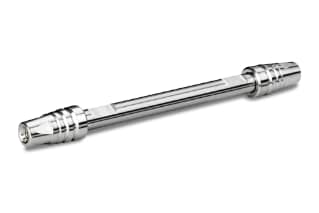
|
Chemistry |
HILIC |
|
Separation Mode |
Hydrophilic Interaction (HILIC) |
|
Particle Substrate |
Silica |
|
pH Range Min |
1 pH |
|
pH Range Max |
5 pH |
|
Temperature Limits |
45 C |
|
Maximum Pressure |
18000 psi (1240 Bar) |
|
Endcapped |
No |
|
Silanol Activity |
High |
|
Particle Shape |
Spherical |
|
Particle Size |
2.7 µm |
|
Endfitting Type |
Parker-style |
|
Pore Size |
90 Å |
|
Format |
Column |
|
Surface Area |
100 |
|
System |
HPLC |
|
Particle Technology |
Solid Core |
|
USP Classification |
L3 |
|
Inner Diameter |
3 mm |
|
Length |
100 mm |
|
eCord |
Yes |
|
UNSPSC |
41115709 |
|
Brand |
CORTECS |
|
Product Type |
Columns |
|
Units per Package |
1 pk |

CORTECS HILIC Column, 90Å, 2.7 µm, 3 mm X 100 mm, 1/pk
High-efficiency columns with a solid-core particle called CORTECS HILIC Columns are made to hold very polar analytes. Compared to C18 columns, they offer orthogonal selectivity. With the help of the CORTECS HILIC Column, you may resolve complex mixtures with exceptional levels of efficiency and performance or maintain resolution while increasing throughput. When compared to standard C18 columns, the CORTECS HILIC Column offers orthogonal selectivity. It is a crucial piece of laboratory apparatus since it is a solid-core, high-efficiency column made to hold strongly polar analytes.
You may anticipate more throughput and quicker separations with the CORTECS HILIC Column. Due to the use of unbonded solid-core particles in reversed phase, the lab apparatus uses the Hydrophilic Interaction Chromatography (HILIC) mode, which was designed to retain polar compounds where reversed-phase could not. High levels of stability and retention are present in the column. In contrast to reversed-phase chromatography, which uses a highly watery mobile phase for the retention of polar analytes, HILIC uses mobile phases with a high concentration of organic solvent. Because it can now interact directly with SPE eluates, sample preparation can be completed more quickly, and throughput can be raised. Higher concentrations of organic solvents enable more efficient desolvation of analytes in the MS source, increasing MS response and sensitivity.
The solid-core particles that make up the CORTECS HILIC Column increase performance by lowering each of the three terms in the van Deemter equation. The A term decreases as the solid core particles pack more evenly. The B term is decreased because axial diffusion is decreased, and particle porosity is smaller in the solid core particles. The C term is lowered by their solid core's improved heat transfer and decreased radial temperature gradients.
In addition to having the ability to contact a member of our international staff for assistance with any questions, issues, or general lab equipment guidance as needed, you will be able to shop for lab equipment from our website.
You may also be interested in CORTECS HILIC VanGuard Cartridge, 90Å, 2.7 µm, 2.1 mm X 5 mm, 3/pk; CORTECS HILIC VanGuard Cartridges are used to extend analytical column lifetime and performance by eliminating particle pollution from the mobile phase stream. All CORTECS HILIC analytical columns with 2.1 mm and 3.0 mm I.D. and 2.7 µm sorbent particles are protected by this cartridge.
What Does 'The Expressions Of A Protein' Refer To?
Protein expression is the term used to describe the processes through which proteins are made, altered, and controlled in living things. The phrase can be used to describe the object of study or the methods used in laboratories to produce proteins for protein research.